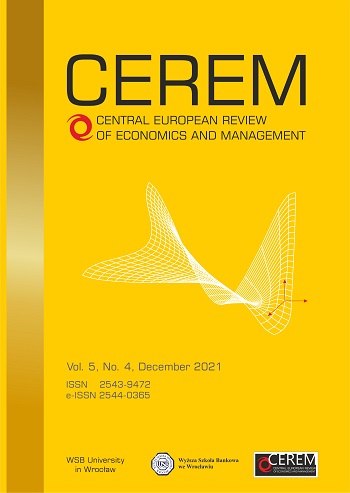Money Growth and Social Stability
DOI:
https://doi.org/10.29015/cerem.931Słowa kluczowe:
Money Velocity, Money Growth, Heterogeneity, CBDC, Wealth Distribution, Sustainable Development Goals, SDG10, Inequalities, InflationAbstrakt
Aim: Both the Keynesian and the Fisherian channels of sovereign money growth have slowed down significantly in the decade following the Global Financial Crisis (GFC). This, together with the rise of fintech, privately issued unbacked crypto-assets tried to fill this void. These developments have revived the interest on the Central Bank Digital Currency (CBDC) idea and on potential channels for future sovereign money growth. The aim of this paper is to compare the Keynesian and Fisherian channels of sovereign money growth regarding their impact on wealth distribution and inflation.
Design / Research Methods: To achieve our aim we use a simple Agent Based Model (ABM) to capture heterogeneity. In our model, the agents are heterogeneous consumers with different spending propensities but with equal initial wealth levels and with exactly same non-interest incomes over time.
Conclusions / findings: We show that Keynesian (uniform) money growth channel has a softening effect on the wealth dispersion and thereby, on the downward pressure on money velocity. The model indicates that the inclusive nature of current post-Covid19 recovery plans may have a desirable impact on social stability. Yet, these plans may also be more inflationary in comparison the post-GFC policies.
Originality / value of the article: This paper shows that heterogeneity of economic agents should not be ignored by policy makers and that ABM is a convenient tool to design and analyse monetary and fiscal policies under heterogeneity.
Implications of the research: The implication for policy makers is that the demand deficiency associated with the fall in money velocity and the worsening of wealth dispersion may be softened by a more inclusive money growth regime, potentially with the practical use of CBDCs. Yet the extra inflationary impact of such a regime need to be kept in mind.
Bibliografia
Arthur W.B. (1991), Designing Economic Agents that Act Like Human Agents. A Behavioural Approach to Bounded Rationality, “American Economic Review”, vol. 81 no. 2, pp. 353–359.
Asano Y., Kolp J.J., Heitzig J., Farmer J.D. (2019), Emergent Inequality and Endogenous Dynamics in a Simple Behavioural Economic Model, “INET Oxford Working Paper”, no. 2019–11.
Basci E. (1999), Learning by Imitation, “Journal of Economic Dynamics and Control”, vol. 25 no. 9, pp. 1569–1585.
Basci S., Gherbi, T. (2020), Demand Deficiency, Money Velocity and Heterogeneity, “Central European Review of Economics and Management”, vol. 4 no. 2, pp. 137–153.
Basci E., Basci S. (2021), Demand Deficiency in G7 Countries, “International Econometric Review, Economics of the 21st Century”, vol. 13 no. 3, pp. 59-70..
Bernanke B.S. (2002), Deflation: Making Sure “It” Doesn’t Happen Here. Remarks before the National Economists Club, Washington, D.C., November 21, https://www.federalreserve.gov/BOARDDOCS/Speeches/2002/20021121/default.htm#f8 [02.12.2021].
BIS (2021), CBDCs: an Opportunity for the Monetary System, Bank for International Settlements Annual Report, Basel, https://www.bis.org/publ/arpdf/ar2021e3.htm [02.12.2021].
Blanchard O. (2021), In Defense of Concerns over the $1.9 Trillion Relief Plan, Peterson Institute for International Economics, February 18, https://www.piie.com/blogs/realtime-economic-issues-watch/defense-concerns-over-19-trillion-relief-plan [02.07.2021].
Carroll C.D., Crawley E., Slacalek J., White M.N. (2021), Modelling the Consumption Response to the CARES Act, “International Journal of Central Banking”, vol. 17 no. 1, pp. 107–141.
Carroll C.D., Slacalek J., Tokuoka K., White M.N. (2017), The Distribution of Wealth and the Marginal Propensity to Consume, “Quantitative Economics”, vol. 8 no. 3, pp. 977–1020.
Domanski D., Scatigna M., Zabai A. (2016), Wealth Inequality and Monetary Policy, “BIS Quarterly Review”, March, pp. 45–64.
English B., Forbes K., Ubide Á (eds.) (2021), Monetary Policy and Central Banking in the Covid Era, CEPR Press, https://voxeu.org/content/monetary-policy-and-central-banking-covid-era [02.12.2021].
Fisher I. (1930), The Theory of Interest, 1st ed., The Macmillan Co., New York.
Galí J. (2020a), The Effects of a Money-Financed Fiscal Stimulus, “Journal of Monetary Economics”, vol. 115, pp. 1–19.
Galí J. (2020b), Helicopter Money: The Time is Now”, VoxEU.org, March 17, https://voxeu.org/article/helicopter-money-time-now [02.12.2021].
Goodhart Ch. (2020), Inflation after the Pandemic: Theory and Practice, VoxEU, June 13, https://voxeu.org/article/inflation-after-pandemic-theory-and-practice [02.12.2021].
Jilek J., Matousek R. (2010), Money in the Modern World, Peter Lang, Frankfurt.
Karamcheva N. (2016), Trends in Family Wealth, Congressional Budget Office, https://www.cbo.gov/publication/51846 [02.12.2021].
Kirman A.P. (1992), Whom or What Does the Representative Individual Represent?, “Journal of Economic Perspectives”, vol. 6 no. 2, pp. 117–136.
Lebaron B. (2001), A Builder’s Guide to Agent-Based Financial Markets, ,”Quantitative Finance”, vol. 1 no. 2, pp. 254–261.
Martin P., Monnet E., Ragot X., Renault T., Savatier B. (2021), Helicopter Money as a Last Resort Contingent Policy, VoxEU, CEPR, April 5, https://voxeu.org/article/helicopter-money-last-resort-contingent-policy [02.12.2021].
McLeay M., Radia A., Thomas R. (2014), Money Creation in the Modern Economy, “Bank of England Quarterly Bulletin”, vol. 54 no. 1, https://www.bankofengland.co.uk/quarterly-bulletin/2014/q1/money-creation-in-the-modern-economy [02.12.2021].
Summers L. (2021), The Biden Stimulus Is Admirably Ambitious. But It Brings Some Big Risks, too. Opinion, The Washington Post, February 7, https://www.washingtonpost.com/opinions/2021/02/04/
larry-summers-biden-covid-stimulus/ [02.12.2021].
Turrell A. (2016), Agent-Based Models: Understanding the Economy from Bottom-up, “Bank of England Quarterly Bulletin”, vol. Q4, pp. 173–188.
Pobrania
Opublikowane
Numer
Dział
Licencja
Autor przenosi nieodpłatnie na Wyższą Szkołę Bankową we Wrocławiu , bez ograniczeń terytorialnych, majątkowe prawa autorskie do tego utworu w rozumieniu ustawy z dnia 4 lutego 1994 roku o prawie autorskim i prawach pokrewnych ( Dz.U. 1994, Nr 24, poz. 83 ze zm. )na zasadzie wyłączności, tj. prawo do:
a) wyłącznego używania i wykorzystania utworu w dowolnej działalności przez Wyższą Szkołę Bankową we Wrocławiu, w szczególności w działalność Biblioteki Cyfrowej uruchomionej przez Wyższą Szkołę Bankową we Wrocławiu
b) wytwarzania, utrwalania i zwielokrotniania egzemplarzy utworów wszelkimi technikami, w tym techniką drukarską, reprograficzną, zapisu magnetycznego oraz techniką cyfrową, w szczególności ich zwielokrotniania poprzez dokonywanie zapisów na płytach typu CD,
c) zamieszczenia wybranych fragmentów utworu w celach promocyjnych w publikacjach, materiałach promocyjnych, w sieci Internet oraz sieciach wewnętrznych typu Intranet Wyższej Szkoły Bankowej we Wrocławiu,
d) wprowadzania utworu do pamięci komputera Wyższej Szkoły Bankowej we Wrocławiu,
e) kopiowania i powielania utworu w technologiach fotomechanicznych lub innych znanych w dniu zawarcia umowy (fotokopie, kserokopie itp.),
f) przetworzenia dzieła na formę elektroniczną i nieograniczonego rozpowszechniania w sieci Internet.


